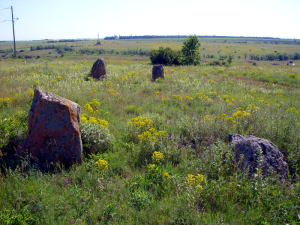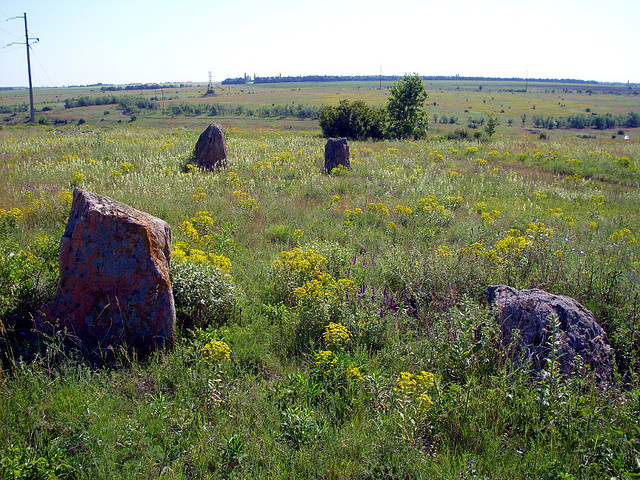
TRINITY COLLEGE DUBLIN—New research indicates that Baltic hunter-gatherers were not swamped by migrations of early agriculturalists from the Middle East, as was the case for the rest of central and western Europe. Instead, these people probably acquired knowledge of farming and ceramics by sharing cultures and ideas—rather than genes—with outside communities.
Scientists extracted ancient DNA from a number of archaeological remains discovered in Latvia and the Ukraine, which were between 5,000 and 8,000 years old. These samples spanned the Neolithic period, which was the dawn of agriculture in Europe, when people moved from a mobile hunter-gatherer lifestyle to a settled way of life based on food production.
We know through previous research that large numbers of early farmers from the Levant (the Near East) – driven by the success of their technological innovations such as crops and pottery – had expanded to the peripheral parts of Europe by the end of the Neolithic and largely replaced hunter-gatherer populations.
However, the new study, published today in the journal Current Biology, shows that the Levantine farmers did not contribute to hunter-gatherers in the Baltic as they did in Central and Western Europe.
The research team, which includes scientists from Trinity College Dublin, the University of Cambridge, and University College Dublin, says their findings instead suggest that the Baltic hunter-gatherers learned these skills through communication and cultural exchange with outsiders.
The findings feed into debates around the ‘Neolithic package,’—the cluster of technologies such as domesticated livestock, cultivated cereals and ceramics, which revolutionised human existence across Europe during the late Stone Age.
Advances in ancient DNA work have revealed that this ‘package’ was spread through Central and Western Europe by migration and interbreeding: the Levant and later Anatolian farmers mixing with and essentially replacing the hunter-gatherers.
But the new work suggests migration was not a ‘universal driver’ across Europe for this way of life. In the Baltic region, archaeology shows that the technologies of the ‘package’ did develop—albeit less rapidly—even though the analyses show that the genetics of these populations remained the same as those of the hunter-gatherers throughout the Neolithic.
________________________________________
The Neolithic peoples of the Baltics acquired agriculture and other elements of permanent settlement culture through diffusion, not through large migratory movements from Anatolia and the Middle East, according to genetic study. Gromko, Wikimedia Commons
__________________________________________
Andrea Manica, one of the study’s senior authors from the University of Cambridge, said: “Almost all ancient DNA research up to now has suggested that technologies such as agriculture spread through people migrating and settling in new areas.”
“However, in the Baltic, we find a very different picture, as there are no genetic traces of the farmers from the Levant and Anatolia who transmitted agriculture across the rest of Europe.”
“The findings suggest that indigenous hunter-gatherers adopted Neolithic ways of life through trade and contact, rather than being settled by external communities. Migrations are not the only model for technology acquisition in European prehistory.”
While the sequenced genomes showed no trace of the Levant farmer influence, one of the Latvian samples did reveal genetic influence from a different external source—one that the scientists say could be a migration from the Pontic Steppe in the east. The timing (5-7,000 years ago) fits with previous research estimating the earliest Slavic languages.
Researcher Eppie Jones, from Trinity College Dublin and the University of Cambridge, was the lead author of the study. She said: “There are two major theories on the spread of Indo-European languages, the most widely spoken language family in the world. One is that they came from the Anatolia with the agriculturalists; another that they developed in the Steppes and spread at the start of the Bronze Age.”
“That we see no farmer-related genetic input, yet we do find this Steppe-related component, suggests that at least the Balto-Slavic branch of the Indo-European language family originated in the Steppe grasslands of the East, which would bring later migrations of Bronze Age horse riders.”
The researchers point out that the time scales seen in Baltic archaeology are also very distinct to the rest of Europe, with a much more drawn-out and piecemeal uptake of Neolithic technologies, rather than the complete ‘package’ that arrives with migrations to take most of Europe by storm.
Andrea Manica added: “Our evidence of genetic continuity in the Baltic, coupled with the archaeological record showing a prolonged adoption of Neolithic technologies, would suggest the existence of trade networks with farming communities largely independent of interbreeding.”
“It seems the hunter-gatherers of the Baltic likely acquired bits of the Neolithic package slowly over time through a ‘cultural diffusion’ of communication and trade, as there is no sign of the migratory wave that brought farming to the rest of Europe during this time.
“The Baltic hunter-gatherer genome remains remarkably untouched until the great migrations of the Bronze Age sweep in from the East.”
About the study
The researchers analysed eight ancient genomes – six from Latvia and two from Ukraine – that spanned a timeframe of three and a half thousand years (between 8,300 and 4,800 years ago). This enabled them to start plotting the genetic history of Baltic inhabitants during the Neolithic.
DNA was extracted from the petrous area of skulls that had been recovered by archaeologists from some of the region’s richest Stone Age cemeteries. The petrous, at the base of the skull, is one of the densest bones in the body, and a prime location for DNA that has suffered the least contamination over millennia.
Article Source: Trinity College Dublin
_____________________________________________________
Subscribe to Popular Archaeology Premium. Available on all laptops and mobile devices, and still the industry’s best value at only $9.00 annually.
___________________________________________
Travel and learn with Far Horizons.
____________________________________________
This richly illustrated issue includes the following stories: Recent findings shedding new light on the whereabouts of the remains of Philip of Macedon, father of Alexander the Great; how an archaeologist-sculptor is bringing bones of the dead back to life; archaeologists uncovering town life at the dawn of civilization; an exclusive interview with internationally acclaimed archaeologist James M. Adovasio about what makes the Meadowcroft Rockshelter prominent in the ongoing search for the first Americans; what archaeologists are finding at the site of the ancient city of Gath, the home town of the biblical Philistine giant, Goliath; and how scientists are redrawing the picture of human evolution in Europe. Find it on Amazon.com.








